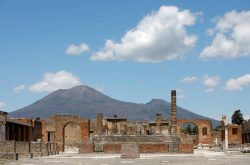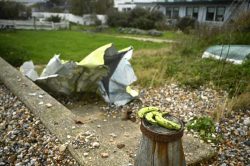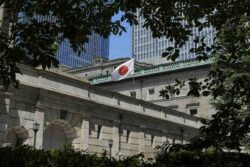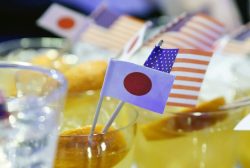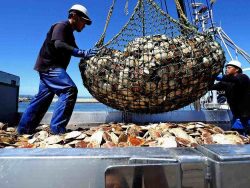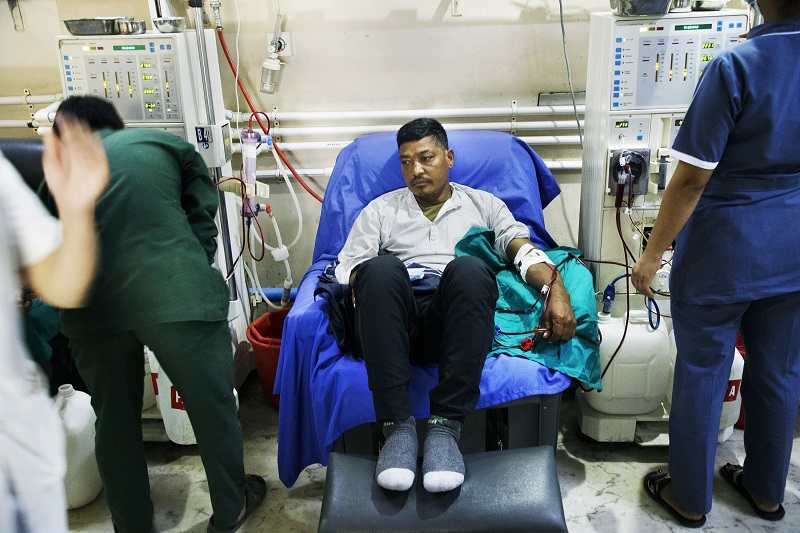
Sak Bahadur Chhantyal, 48, was working on a construction site in Oman for six years before he was diagnosed with chronic kidney disease. He has been on dialysis at the National Kidney Center in Kathmandu for almost two years.
17:22 JST, January 7, 2023
JANAKPUR, Nepal – Head nurse Rani Jha circled around her busy kidney ward, reeling off the list of patients who were too young, too sick, too many to count.
There, lying against the far wall, was Tilak Kumar Shah, who had worked in construction for seven years in the Persian Gulf before collapsing. The next bed had belonged to Mohan Yadav, who had labored in Qatar – until he died two weeks earlier. Next to Jha’s cubicle, huddling quietly under a blanket, was another typical case: Suraj Thapa Magar, a shy 28-year-old who had left his mud hut in Nepal to install windows on skyscrapers in Kuwait, often dangling by a rope in the scorching, 120-degree purgatory between the sun and the desert.
Jha ran her finger through a large notebook filled with names written neatly in ink. About 20 percent of the dialysis patients at the Second Provincial Hospital in southern Nepal were healthy young men before they went abroad to work, she estimated. Why did they keep getting sick and ending up back here?
“Heat,” she said.
In recent years, scientists and groups including the International Labor Organization have increasingly warned about the deadly, yet often overlooked, link between exposure to extreme heat and chronic kidney disease. Exactly how heat scars and cripples the microscopic tubes in the organs is still debated, researchers say, but the correlation is clear.
That link has been observed among workers toiling in rice fields in Sri Lanka and steamy factories in Malaysia, from Central America to the Persian Gulf. As the world grows hotter and climate change ushers in more frequent and extreme heat waves, public health experts fear kidney disease cases will soar among laborers who have no choice but to work outdoors.
“These epidemics of chronic kidney disease that have surfaced . . . [are] just the beginning,” said Richard Johnson, a professor of medicine at the University of Colorado who is studying pockets of kidney disease globally. “As it gets hotter, we expect to see these diseases emerge elsewhere.”
In an April statement on climate change, the American Society of Nephrology warned that “the confluence of socioeconomic, geographic, and climate change risk factors may increase the incidence of kidney disease.” The association of kidney specialists noted that global surface temperatures are expected to rise by 2 degrees Celsius (3.6 degrees Fahrenheit) by mid-century, and pointed to one population of particular concern: the global poor who must work “in an increasingly hostile outdoor environment.”
A glimpse of that future is emerging in Nepal, local and international researchers say. Here, in a small and impoverished nation that sends nearly 1 in 10 people abroad to work – often in some of the world’s hottest places – the disease, and its consequences, can be seen with devastating clarity.
In the villages that dot Nepal’s impoverished plains and Himalayan hillsides, working abroad has long been considered the best and only route out of a country ranked 163rd in the world in per capita income, where a day’s hard labor earns a bag of rice. Instead, the journey is sending back men crippled with an incurable disease. It is forcing their families to confront soaring costs, crushing debts, social isolation – and often a desperate, murky search for a new kidney.
In 2021, researchers at the Bournemouth University surveyed Nepal’s nephrologists and found three-fourths said they saw a correlation between men working abroad and increased risk of kidney disease.
Pukar Shrestha, a prominent Nepalese surgeon, agrees. When he opened Nepal’s first organ transplant center in the picturesque hills outside Kathmandu in 2013, Shrestha expected to perform kidney transplants almost exclusively for elderly patients with diabetes.
After 300 operations, Shrestha noticed something unexpected, he said. One-third of his patients were young men without histories of diabetes or high blood pressure. But they would show up needing transplants, their kidneys badly scarred, shrunken to half their normal size.
“They’d tell me, ‘I came back from Saudi, Malaysia, Qatar,'” Shrestha recalled. “It was a huge number.”
“I said: ‘there’s something wrong.'”
– – –
For centuries, Nepalese have left their homeland to work. They fought for the Sikh Empire, deployed in the Falkland Islands for the British army, and served as police officers in Hong Kong. Mostly they went to neighboring India.
In 1985, Nepal’s government began regulating overseas employment beyond the subcontinent, and a private labor recruitment industry flourished. Colloquially called “manpower agencies,” the recruiters sent men to work in construction, manufacturing and agriculture in Southeast Asia and the Persian Gulf. In 2022, remittances made up 22 percent of Nepal’s economy, according to the World Bank.
“Nepalese workers are comparatively cost effective,” the Nepalese Embassy in Qatar advertises on its website. “Nepalese workers are experienced in working in the extreme climatic conditions.”
Before he began installing windows in Kuwait, Suraj queued in a packed recruitment office in early 2018, clutching his passport. Like many in Dhanusha district, a stretch of mosquito-plagued marshes that sends more workers abroad than any other district in Nepal, he had no choice.
In his village of Lakhinpur, half of the 40 households sent men to work in the Persian Gulf. Those who stayed behind earned 4 to 8 kilos of rice a day, worth less than $1, by cutting grass and hauling bags of sand. Suraj’s family struggled even more than most, he recalled: his father died when he was 6, leaving him to be raised by his only sibling, Panmaya, a sister 14 years older. Panmaya’s husband couldn’t feed their extended family of eight by working as a mason making $5 a day. Suraj had to go abroad.
“No family wants their sons to go work in scorching heat,” he said. “But we were in financial crisis, so everyone gave me their blessing.”
Before Suraj left home, Panmaya took out a $1,000 loan to pay the recruitment agency, she said. She took him to buy new shoes and shirts.
“You’re the only son of the family,” she told him. “If you can’t handle the work, come home.”
That May, Panmaya handed Suraj some of her savings – $25 in cash – and sent him away.
Six months later, Suraj found himself on construction sites where he installed massive, one-ton window frames on skyscrapers rising from the Kuwait desert. Because elevators were not operational, he recounted, he had to walk several stories to access water. But with work schedules so pressing, most workers gathered around the water tank only during their one-hour break. On many days, the water would be gone before the break ended. Often, Suraj didn’t drink anything all day.
Suraj would send Panmaya $150 in earnings every month, so she could buy fish to eat. Back in Lakhinpur, he started building a concrete house with white plaster walls and a propane stove – an upgrade from the two mud-and-bamboo huts where he lived with Panmaya. He would send Panmaya photos of himself 60 stories high in the air, promising he would be careful.
Suraj avoided every hazard, except the one that quietly ravaged his kidneys.
One day in January, Suraj collapsed with dizziness and pain shot through his torso and swollen legs. When he checked himself into Kuwait’s Farwaniya Hospital, his Indian doctor took one look, Suraj recalled, and immediately sent him to the intensive care unit.
Suraj had severe anemia and developed a blood clot in his stomach. Before long, he lost consciousness and would need eight pints of blood replaced, according to his Kuwaiti medical records. The diagnosis: end-stage renal disease.
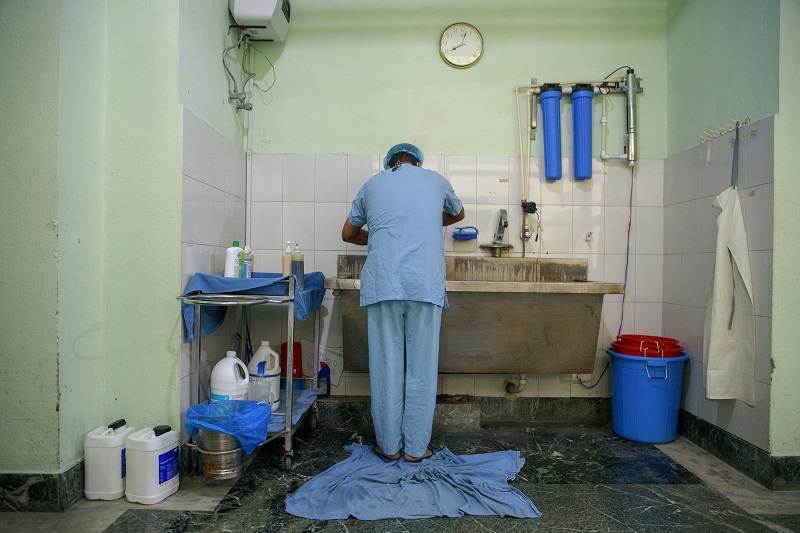
Pukar Chandra Shrestha, a nephrologist and the executive director of the Human Organ Transplant Center in Bhaktapur, Nepal, washes his hands before surgery.
– – –
Medical researchers have long established the link between heat and kidney damage. When the body is severely dehydrated, calcium and uric acid in urine form crystals, scarring the kidneys. When internal temperatures soar past 104 degrees, organs, including the brain, can break down.
Until the past decade, physicians believed that the acute damage inflicted by dehydration and heat was unlikely to lead to kidney failure. That view is now shifting, researchers say, as experiments on dehydrated mice and studies of farmworkers indicate otherwise. Scientists are also debating whether exposure to pesticides and fumes, poor diets and genetics help trigger the disease among outdoor workers – or if heat is the primary culprit.
Because kidney function can decline without showing symptoms, workers like Suraj often go undiagnosed until they reach the latter stages of the irreversible disease. At that point, they require dialysis, an expensive treatment, three times a week merely to survive. To regain a normal life, they need a new kidney.
Jason Glaser, head of La Isla Network, a public health group in Washington that has coordinated kidney research around the world, said heat-induced kidney disease will be a “double burden” in the coming decades.
“You’re removing workers in their prime from their households and societies, while adding that burden to public health systems,” he said. “This disease affects the families and countries that can afford it least.”
In 2016, the Nepalese government began to offer free dialysis at an estimated cost of more than 2 percent of its annual health budget. That eliminated a significant burden for patients. But for many migrant workers, the cost of treatment is still prohibitive: Erythropoietin to boost red cells, iron supplements and blood transfusions add up to hundreds of dollars a month – more than what the workers ever made overseas.
Babu Tarung stared blankly at the ceiling in Kathmandu’s National Kidney Center, telling a variation of a common tale in these crowded halls. The 40-year-old came home sick in 2021 after assembling egg carton boxes in a sauna-like warehouse in Malaysia. He spent thousands of dollars on tissue-matching tests and immunosuppressant drugs to receive a kidney from his mother. To fund it all, he sold his ancestral farm in the Himalayas.
Then the coronavirus lockdown hit in 2020. By the time it lifted, Tarung’s organ-matching tests had expired. He was already bankrupt.
Still, Tarung said, he had $500 in monthly medical bills to pay and a family to support. So he ignored his doctor’s warnings that his bones had turned brittle due to kidney failure and kept installing floors at Nepali construction sites on days he didn’t have dialysis. Whenever he felt weak or dizzy, he said, he’d rest 30 minutes and get back up.
“Nepalese boys can do anything,” he said. “Making money is the most important thing in the world.”
– – –
Even for those with money, a new kidney is never guaranteed.
Faced with a burgeoning black-market kidney trade in 1998, Nepal passed a law permitting donations only between close relatives. These days, when workers come home with failing kidneys, it often sets off a scramble to find a matching – or willing – donor. Krishna Kumar Sah, a nephrologist in Dhanusha district, said many Nepalese are loath to donate, so he has seen sick men beg, even bribe, their siblings for a kidney.
Other families simply unravel, social workers say.
For 16 years, Krishna Khadka was a hero in his family because he welded pipelines at Qatari gas plants. When he came home sick, his family quickly ostracized him, said his wife, Sangeeta, who is ineligible to donate her kidney because of her medical history.
“Nobody talks to us. They don’t want to start the conversation” about donating, Sangeeta said. “During the holidays, it’s just the four of us.”
Recently, the family has been debating one last possibility, Sangeeta said. Their younger daughter, Laxmi, 17, volunteered to donate once she becomes an adult.
Sitting on the bed that occupies half the space of the Khadkas’ 10-foot-by-10-foot home in Kathmandu, Krishna, 51, pondered his dilemma and shook his head. “I can do dialysis and live 10 more years,” he said. “My child has her entire life.”
A few miles north, in a shantytown in the foothills, two young men described another option: buying a kidney.
A taxi driver in their neighborhood named Prem had connected the two men. Prem assured the buyer that he was getting a good price. He assured the seller that he’d cope fine with one kidney. In a smoky hookah bar, he told a Washington Post reporter that a kidney in some remote villages went for as little as $800 and here, he was brokering a fair deal: a kidney for $6,000.
Forging the paperwork to show kinship was “difficult, not impossible,” said the buyer, a 31-year-old returnee who saved money working in construction in Dubai and running a shop back in Nepal. The seller, a painfully shy 29-year-old, said he already put a lien on his farm. He could barely afford food and couldn’t take his wife, four months pregnant, to see an obstetrician. Both men spoke on the condition of anonymity, and Prem did not provide his last name to discuss an illegal exchange.
Among the reasons the seller needed money: he had borrowed $3,000 to pay recruiters for work in Saudi Arabia but quit after six months. Like the buyer, the seller was back where he started, more desperate than before.
“Physically, I see no harm,” he said. “I know someone in my village who already did it.”
– – –
In Nepal, physicians broadly agree they are seeing abnormal rates of kidney disease. They agree heat is a key factor. Still, the issue remains something of an open secret.
“It’s a sensitive issue,” said Dinesh Neupane, a Johns Hopkins public health researcher who is studying the disease in Nepal. “It’s a small country that relies on remittances, and the fear is if host countries respond negatively, many Nepalis will suffer. But who will speak for the migrant workers?”
Officially, the Labor Ministry says it is “generally aware” of health issues facing returnees. In response to questions, Thaneshwar Bhusal, a ministry spokesman, did not specifically address kidney disease but he said the government has been conducting awareness campaigns to urge workers in hot environments to drink water and maintain healthy diets.
The vast industry that sends men abroad says it’s not aware of kidney cases. Prem Katuwal, acting coordinator for the Nepal Association of Foreign Employment Agencies, an umbrella organization of 859 middleman firms, said that in 32 years he has heard of broken legs and lost hands but never kidney disease. “We have had one or two deaths out of 100 or 1,000,” he said. “The entire young generation is over there contributing GDP. They’re very much happy.”
Every day, about 1,500 Nepalese men – they are almost all men – continue to leave home, with Malaysia, Qatar and Saudi Arabia the top three destinations. Among those who have returned sick, Suraj said he considered himself relatively lucky.
After he woke up in Kuwait and the doctor told him what happened, Suraj first felt terrified, he said, then ashamed. He didn’t want to tell Panmaya that his body had failed and he could no longer work.
“Just come home,” his sister pleaded. She promised that they would face his illness together. And in the past year, they’ve overcome hurdles that frayed other families.
Almost immediately, Panmaya said she would donate a kidney. She wheels Suraj to the hospital, a few times a week. To pay for the transplant and the tests, they’ll sell Suraj’s half-built house with the propane stove. They’ll squeeze back into Panmaya’s mud-and-bamboo hut and cook on the ground with open fire.
His dream of getting married was now “in ashes,” Suraj admitted, sitting next to Panmaya back in her yard. But he would take care of Panmaya’s children. She’ll scrounge together money and still cook fish.
Any day now, they’ll go for another round of organ-matching tests. Then they’ll go to Kathmandu for the transplant.
“I’m not afraid,” Panmaya said. “Because he’ll be able to live.”
She held back tears, and added: “He’ll be able to work.”
"News Services" POPULAR ARTICLE
-

American Playwright Jeremy O. Harris Arrested in Japan on Alleged Drug Smuggling
-

Japan’s Nikkei Stock Average as JGB Yields, Yen Rise on Rate-Hike Bets
-

Japan’s Nikkei Stock Average Licks Wounds after Selloff Sparked by BOJ Hike Bets (UPDATE 1)
-

Japanese Bond Yields Zoom, Stocks Slide as Rate Hike Looms
-

Japan’s Nikkei Stock Average Buoyed by Stable Yen; SoftBank’s Slide Caps Gains (UPDATE 1)
JN ACCESS RANKING
-

Keidanren Chairman Yoshinobu Tsutsui Visits Kashiwazaki-Kariwa Nuclear Power Plant; Inspects New Emergency Safety System
-

Imports of Rare Earths from China Facing Delays, May Be Caused by Deterioration of Japan-China Relations
-

University of Tokyo Professor Discusses Japanese Economic Security in Interview Ahead of Forum
-

Japan Pulls out of Vietnam Nuclear Project, Complicating Hanoi’s Power Plans
-

Govt Aims to Expand NISA Program Lineup, Abolish Age Restriction







